Top Roofing Maintenance Tips from Industry Professionals

Maintaining a sturdy and reliable type of roof is essential for the protection and longevity of any home. Whether you’re dealing with minor repairs or contemplating a full replacement, understanding the best practices in roofing can save you time, money, and stress. In this guide, we’ve compiled the top roofing tips from industry experts to help you navigate the complexities of roof maintenance and ensure your home remains safe and secure from the elements.
6 Exclusive Tips on How to Best Maintain Your Roof
1. Regular Inspections are a Key
Regular inspections are crucial to maintaining the longevity of your roof. Experts recommend conducting a professional roof inspection at least twice a year, ideally in the spring and fall. These inspections can identify minor issues such as loose shingles or damaged flashing before they develop into major problems.
Homeowners should make a habit of visually inspecting their roofs after severe weather events. Look for signs of damage such as missing shingles, sagging, or debris accumulation. Promptly addressing these issues can prevent costly repairs and extend the life of your roof. You can click here or do some research to learn more about the importance of regular roof inspections. It’s also essential to maintain a record of all inspections and repairs, as this can be useful for insurance purposes or when selling your home.
2. Proper Ventilation and Insulation

Proper ventilation and insulation are critical components of a healthy roof. Without adequate ventilation, heat and moisture can accumulate in the attic, leading to issues like mold growth and structural damage. Installing ridge vents, soffit vents, and attic fans can help manage temperature and moisture levels effectively. Insulation, on the other hand, serves to maintain a consistent temperature inside your home, reducing the strain on your HVAC system.
Insufficient insulation can cause your roof to deteriorate more quickly due to temperature fluctuations and condensation. Ensure your attic is well-insulated to promote a durable and energy-efficient roofing system.
3. Choosing the Right Materials
Selecting the right materials for your roof is essential for durability and performance. Asphalt shingles are popular due to their cost-effectiveness and ease of installation, while metal roofing offers longevity and resilience in extreme weather conditions. Each material has its pros and cons, so carefully consider your local climate and budget.
Investing in high-quality materials may have a higher upfront cost but can save you money in the long run by reducing maintenance and extending the life of your roof. Consulting with a roofing expert can help you make informed decisions about the best materials for your specific needs.
4. Gutter Maintenance
Gutters play a pivotal role in safeguarding your roof by directing water away from your home’s foundation. Keeping your gutters clean and free of debris is essential to prevent water damage and maintain the structural integrity of your roof. Clogged gutters can cause water to back up and seep under the shingles, leading to leaks and potential rot.
Schedule regular gutter cleanings, especially in the fall when leaves are most likely to accumulate. Installing gutter guards can also help minimize debris buildup and reduce the frequency of cleanings needed. Remember, well-maintained gutters are a vital component of a healthy roofing system.
5. Addressing Minor Repairs Promptly

Minor roof repairs, if left unaddressed, can quickly escalate into significant issues. Small leaks, missing shingles, or tiny punctures can seem inconsequential, but they can allow moisture to enter your home, causing extensive damage over time. It’s far more cost-effective to address these small problems as soon as they arise.
Homeowners should never attempt to make repairs themselves unless they have the proper training and equipment. DIY repairs can result in further damage or even injury. Instead, contact a professional roofing contractor to ensure that repairs are done correctly and safely.
6. Preparing for Seasonal Changes
Different seasons pose unique challenges for your roof. In the winter, snow and ice can cause significant damage if your roof isn’t properly prepared. Ensure your roof can handle the extra weight and check for ice dams that can lead to leaks. Using a roof rake to remove heavy snow after storms can also help prevent damage.
In the summer, the intense heat and UV rays can take a toll on your shingles, causing them to crack or warp. Applying a protective coating can help mitigate sun damage. Additionally, ensure your attic is well-ventilated to reduce heat buildup. Preparing your roof for each season can significantly extend its lifespan and ensure optimal performance year-round.
Final Words
Maintaining a healthy roof requires regular inspections, proper ventilation and insulation, selecting the right materials, gutter maintenance, prompt repairs for minor issues, and preparations for seasonal changes. By following these top roofing tips from industry experts and staying proactive in your roof maintenance, you can ensure the safety and longevity of your home’s most crucial protective structure. Remember to always consult with a professional roofing contractor for any major repairs or replacements to guarantee quality workmanship and long-lasting results.

news via inbox
Sign up and never miss out on the latest news and updates at HighStuff



